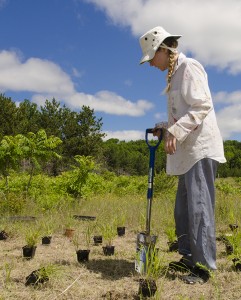Volunteers work to restore one of Ontario’s last tallgrass prairie habitats

Dalila Secker has been coming to the Goodrich Loomis Conservation Area for many years. She also worked as a summer student one year cutting grass. She and 14 others volunteered their time Wednesday morning and planted 2000 native prairie grasses . Historically the area was covered in tall grasses, now habitats such as this are in danger of becoming extinct. Photo by Gail Paquette
By Gail Paquette
Fifteen volunteers worked hard Wednesday morning to restore one of the most endangered ecosystems in Canada.
The group was out at 9 a.m. planting native prairie grasses that once thrived in the area.
Historically the Rice Lake Plains on which Goodrich, Loomis Conservation Area, north of Brighton sits on was covered with tall prairie grasses. Today is it badly overgrown and fragmented allowing invasive and non-native species to spread.
Because only a few remnant sites remain of this natural habitat in Canada, Lower Trent Conservation is working on restoration.
“Much wildlife like the bobolink and meadowlark depends on this now rare habitat for survival. Unfortunately they are unable to adapt to other eco systems,” said Marilyn Bucholtz, Communications Coordinator for Lower Trent Conservation.
The ground was minimally prepared for planting.
“We were lucky with the rain last night,“ said Dave Impey, a lands program developer for LTC. “We may come back and soak this field one more time, then that is all that will be required.”
Over five years ago a similar planting was done in the Campbellford area and was a great success said Impey. It has already spread more then 10 feet in diameter.
“Because of agriculture and urban development there are only small pockets of lands such as this left,” he said. ”It is important we keep those areas as natural as possible.”
An open field along the North View trail at the conservation area is now home to 2000 native grasses including little and big bluestem and Indian grass.
“Keeping the lands bio diverse boosts the eco-system,” said Impey. ”This means that each species no matter how small or tall all are recognized for the important role they play.”
 Print This Post
Print This Post






